stop start Citroen C4 2014 2.G Owner's Guide
[x] Cancel search | Manufacturer: CITROEN, Model Year: 2014, Model line: C4, Model: Citroen C4 2014 2.GPages: 340, PDF Size: 28.99 MB
Page 97 of 340
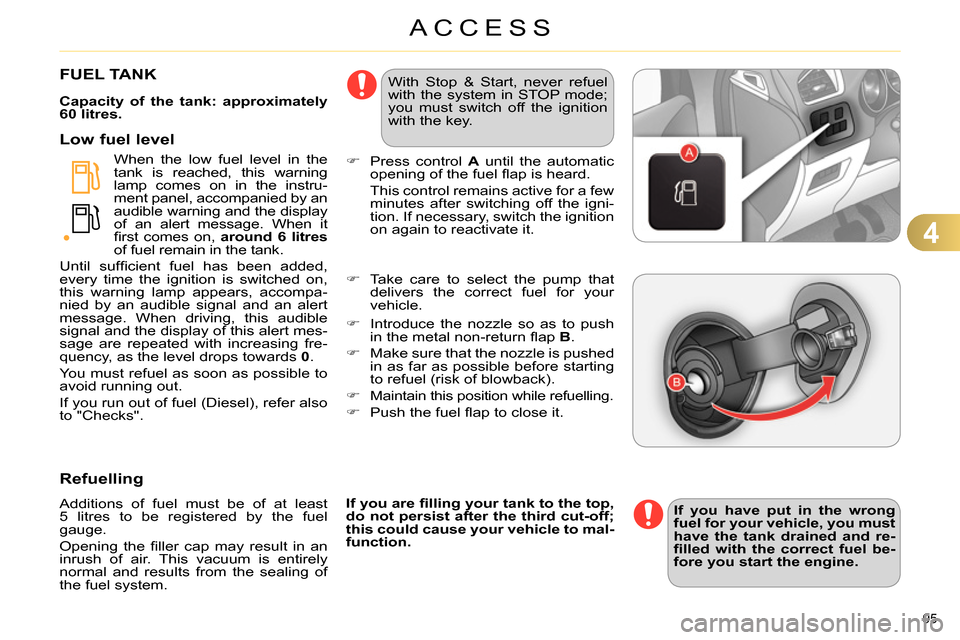
4
ACCESS
95
FUEL TANK
Capacity of the tank: approximately
60 litres.
When the low fuel level in the
tank is reached, this warning
lamp comes on in the instru-
ment panel, accompanied by an
audible warning and the display
of an alert message. When it
fi rst comes on, around 6 litres
of fuel remain in the tank.
Until suffi cient fuel has been added,
every time the ignition is switched on,
this warning lamp appears, accompa-
nied by an audible signal and an alert
message. When driving, this audible
signal and the display of this alert mes-
sage are repeated with increasing fre-
quency, as the level drops towards 0
.
You must refuel as soon as possible to
avoid running out.
If you run out of fuel (Diesel), refer also
to "Checks".
Low fuel level
Refuelling
Additions of fuel must be of at least
5 litres to be registered by the fuel
gauge.
Opening the fi ller cap may result in an
inrush of air. This vacuum is entirely
normal and results from the sealing of
the fuel system.
If you have put in the wrong
fuel for your vehicle, you must
have
the tank drained and re-
fi lled with the correct fuel be-
fore you start the engine.
Press control A
until the automatic
opening of the fuel fl ap is heard.
This control remains active for a few
minutes after switching off the igni-
tion. If necessary, switch the ignition
on again to reactivate it.
If you are fi lling your tank to the top,
do not persist after the third cut-off;
this could cause your vehicle to mal-
function.
Take care to select the pump that
delivers the correct fuel for your
vehicle.
With Stop & Start, never refuel
with the system in STOP mode;
you must switch off the ignition
with the key.
Introduce the nozzle so as to push
in the metal non-return fl ap B.
Make sure that the nozzle is pushed
in as far as possible before starting
to refuel (risk of blowback).
Maintain this position while refuelling.
Push the fuel fl ap to close it.
Page 120 of 340
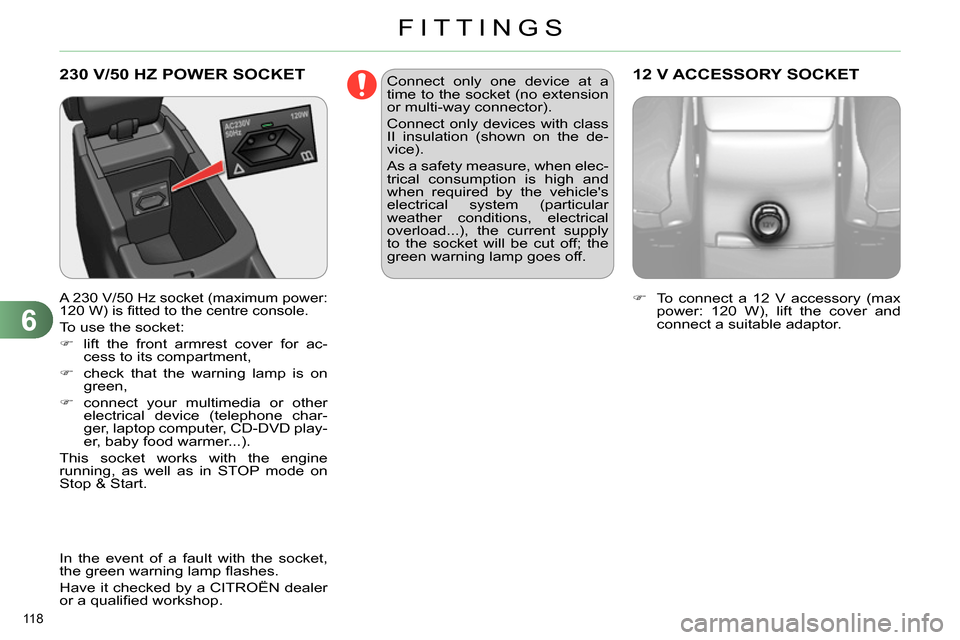
6
FITTINGS
118
230 V/50 HZ POWER SOCKET
A 230 V/50 Hz socket (maximum power:
120 W) is fi tted to the centre console.
To use the socket:
lift the front armrest cover for ac-
cess to its compartment,
check that the warning lamp is on
green,
connect your multimedia or other
electrical device (telephone char-
ger, laptop computer, CD-DVD play-
er, baby food warmer...).
This socket works with the engine
running, as well as in STOP mode on
Stop & Start.
To connect a 12 V accessory (max
power: 120 W), lift the cover and
connect a suitable adaptor.
12 V ACCESSORY SOCKET
Connect only one device at a
time to the socket (no extension
or multi-way connector).
Connect only devices with class
II insulation (shown on the de-
vice).
As a safety measure, when elec-
trical consumption is high and
when required by the vehicle's
electrical system (particular
weather conditions, electrical
overload...), the current supply
to the socket will be cut off; the
green warning lamp goes off.
In the event of a fault with the socket,
the green warning lamp fl ashes.
Have it checked by a CITROËN dealer
or a qualifi ed workshop.
Page 156 of 340
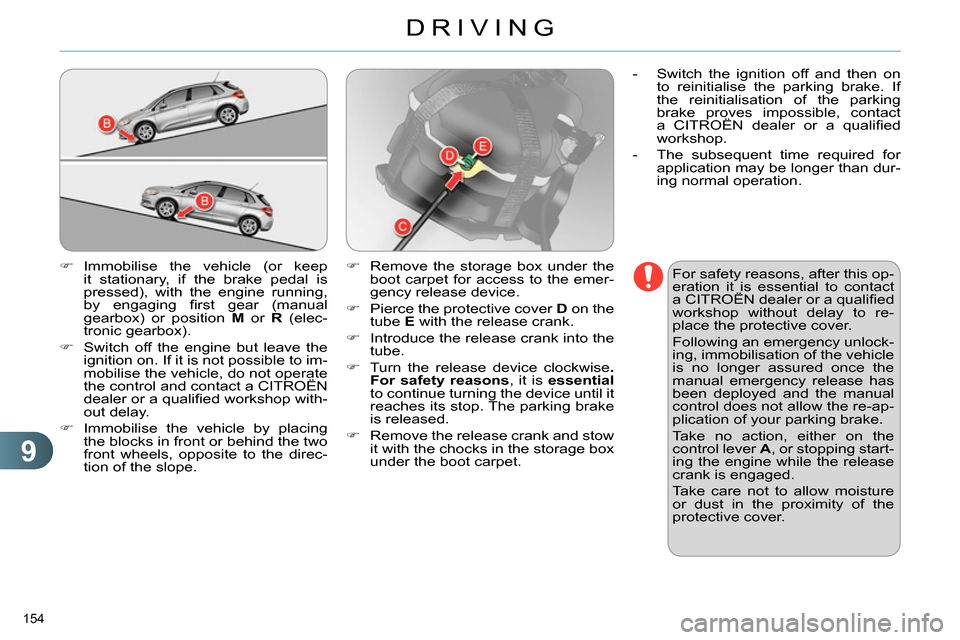
9
DRIVING
154
Immobilise the vehicle (or keep
it stationary, if the brake pedal is
pressed), with the engine running,
by engaging fi rst gear (manual
gearbox) or position M
or R
(elec-
tronic gearbox).
Switch off the engine but leave the
ignition on. If it is not possible to im-
mobilise the vehicle, do not operate
the control and contact a CITROËN
dealer or a qualifi ed workshop with-
out delay.
Immobilise the vehicle by placing
the blocks in front or behind the two
front wheels, opposite to the direc-
tion of the slope.
For safety reasons, after this op-
eration it is essential to contact
a CITROËN dealer or a qualifi ed
workshop without delay to re-
place the protective cover.
Following an emergency unlock-
ing, immobilisation of the vehicle
is no longer assured once the
manual emergency release has
been deployed and the manual
control does not allow the re-ap-
plication of your parking brake.
Take no action, either on the
control lever A
, or stopping start-
ing the engine while the release
crank is engaged.
Take care not to allow moisture
or dust in the proximity of the
protective cover.
Remove the storage box under the
boot carpet for access to the emer-
gency release device.
Pierce the protective cover D
on the
tube E
with the release crank.
Introduce the release crank into the
tube.
Turn the release device clockwise .
For safety reasons
, it is essential
to continue turning the device until it
reaches its stop. The parking brake
is released.
Remove the release crank and stow
it with the chocks in the storage box
under the boot carpet.
- Switch the ignition off and then on
to reinitialise the parking brake. If
the reinitialisation of the parking
brake proves impossible, contact
a CITROËN dealer or a qualifi ed
workshop.
- The subsequent time required for
application may be longer than dur-
ing normal operation.
Page 159 of 340
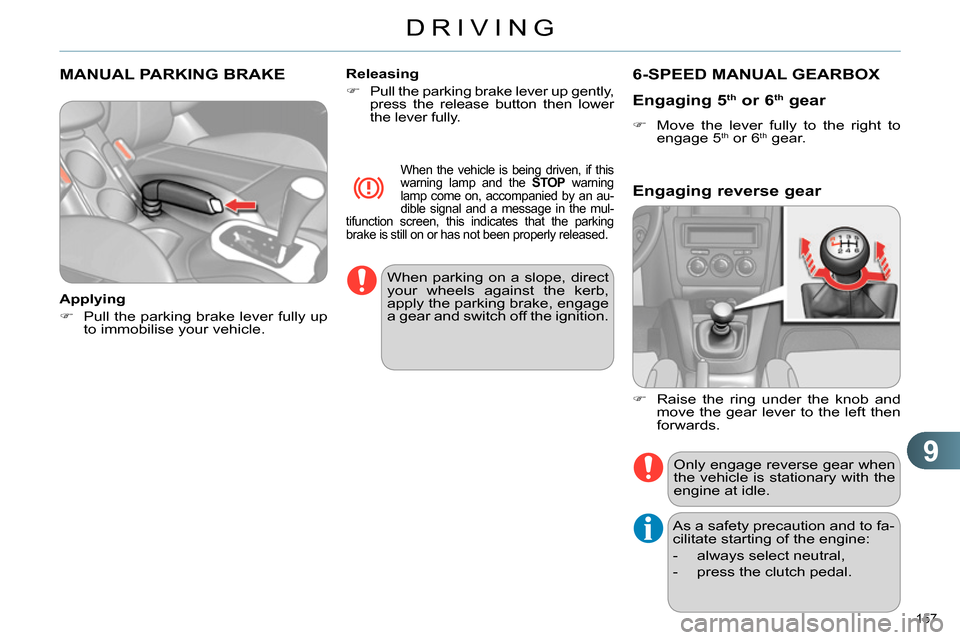
9
DRIVING
157
MANUAL PARKING BRAKE
Applying
Pull the parking brake lever fully up
to immobilise your vehicle.
Releasing
Pull the parking brake lever up gently,
press the release button then lower
the lever fully.
When the vehicle is being driven, if this
warning lamp and the STOP
warning
lamp come on, accompanied by an au-
dible signal and a message in the mul-
tifunction screen, this indicates that the parking
brake is still on or has not been properly released.
When parking on a slope, direct
your wheels against the kerb,
apply the parking brake, engage
a gear and switch off the ignition.
6-SPEED MANUAL GEARBOX
Engaging 5
th
or 6 th
gear
Move the lever fully to the right to
engage 5 th or 6 th
gear.
Only engage reverse gear when
the vehicle is stationary with the
engine at idle.
As a safety precaution and to fa-
cilitate starting of the engine:
- always select neutral,
- press the clutch pedal.
Engaging reverse gear
Raise the ring under the knob and
move the gear lever to the left then
forwards.
Page 170 of 340
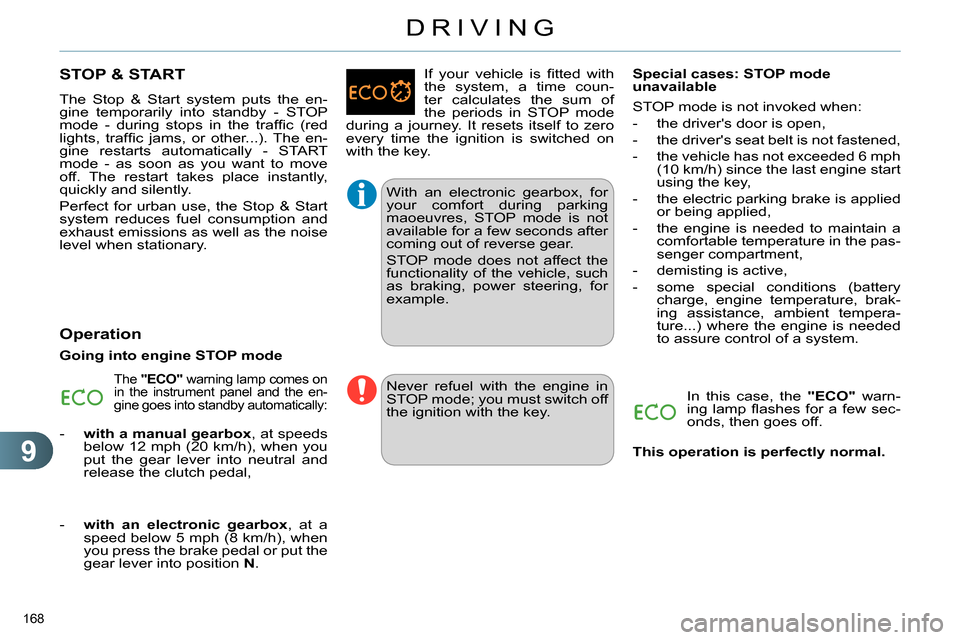
9
DRIVING
168
STOP & START
The Stop & Start system puts the en-
gine temporarily into standby - STOP
mode - during stops in the traffi c (red
lights, traffi c jams, or other...). The en-
gine restarts automatically - START
mode - as soon as you want to move
off. The restart takes place instantly,
quickly and silently.
Perfect for urban use, the Stop & Start
system reduces fuel consumption and
exhaust emissions as well as the noise
level when stationary.
Operation
Going into engine STOP mode
The "ECO"
warning lamp comes on
in the instrument panel and the en-
gine goes into standby automatically:
- with a manual gearbox
, at speeds
below 12 mph (20 km/h), when you
put the gear lever into neutral and
release the clutch pedal, If your vehicle is fi tted with
the system, a time coun-
ter calculates the sum of
the periods in STOP mode
d uring a journey. It resets itself to zero
every time the ignition is switched on
with the key.
- with an electronic gearbox
, at a
speed below 5 mph (8 km/h), when
you press the brake pedal or put the
gear lever into position N
. With an electronic gearbox, for
your comfort during parking
maoeuvres, STOP mode is not
available for a few seconds after
coming out of reverse gear.
STOP mode does not affect the
functionality of the vehicle, such
as braking, power steering, for
example.
Special cases: STOP mode
unavailable
STOP mode is not invoked when:
- the driver's door is open,
- the driver's seat belt is not fastened,
- the vehicle has not exceeded 6 mph
(10 km/h) since the last engine start
using the key,
- the electric parking brake is applied
or being applied,
- the engine is needed to maintain a
comfortable temperature in the pas-
senger compartment,
- demisting is active,
- some special conditions (battery
charge, engine temperature, brak-
ing assistance, ambient tempera-
ture...) where the engine is needed
to assure control of a system.
In this case, the "ECO"
warn-
ing lamp fl ashes for a few sec-
onds, then goes off. Never refuel with the engine in
STOP mode; you must switch off
the ignition with the key.
This operation is perfectly normal.
Page 171 of 340

9
DRIVING
169
Deactivation
Going into engine START mode
At any time, press the "ECO OFF"
switch to deactivate the system.
This is confi rmed by the switch warning
lamp coming on accompanied by the
display of a message.
Special cases: START invoked
automatically
If the system has been deacti-
vated in STOP mode, the engine
restarts immediately. The "ECO"
warning lamp goes
off and the engine starts auto-
matically:
- with a manual gearbox
, when you
fully
depress the clutch pedal,
- with an electronic gearbox
:
●
gear lever in position A
or M
, when
you release the brake pedal,
●
or gear lever in position N
and the
brake pedal released, when you
move the gear lever to position A
or M
,
●
or when you engage reverse
gear.
For safety reasons or to ensure smooth
operation, START mode is invoked au-
tomatically when:
- you open the driver's door,
- you unfasten the driver's seat belt,
- the speed of the vehicle exceeds
15 mph (25 km/h) with a manual
gearbox or 7 mph (11 km/h) with an
electronic gearbox,
- the electric parking brake is being
applied,
- some special conditions (battery
charge, engine temperature, brak-
ing assistance, ambient tempera-
ture...) where the engine is needed
to assure control of a system.
In this case the "ECO"
warning
lamp fl ashes for few seconds,
then goes off.
With a manual gearbox in STOP
mode, if a gear is engaged with-
out fully depressing the clutch
pedal, a warning lamp comes
on or an alert message is dis-
played asking you to depress
the clutch pedal to restart the
engine.
Reactivation
Press the "ECO OFF"
switch again.
The system is active again; this is con-
fi rmed by the switch warning lamp go-
ing off and the display of a message.
The system is reactivated auto-
matically at every new start us-
ing the key.
This operation is perfectly normal.
Page 172 of 340

9
DRIVING
170
Maintenance
In the event of a malfunction with the sys-
tem, the "ECO OFF"
switch warning lamp
fl ashes, then comes on continuously.
Have it checked by a CITROËN dealer or
a qualifi ed workshop.
Operating fault
Before doing anything under the
bonnet, deactivate the Stop &
Start system to avoid any risk of
injury resulting from automatic
operation of START mode.
This system requires a specifi c battery
with a special specifi cation and technol-
ogy (reference numbers available from
a CITROËN dealer or a qualifi ed work-
shop).
Fitting a battery not listed by
CITROËN introduces the risk of mal-
function of the system.
The Stop & Start system makes
use of advanced technology. All
work on this type of battery must
be done only by a CITROËN
dealer or a qualifi ed workshop.
In the event of a fault in STOP
mode, the vehicle may stall. All
of the instrument panel warning
lamps come on.
Depending on version, an alert
message may also be displayed
asking you to put the gear lever
into position N
and put your foot
on the brake pedal.
It is then necessary to switch off
the ignition, then restart the en-
gine using the key.
Page 187 of 340
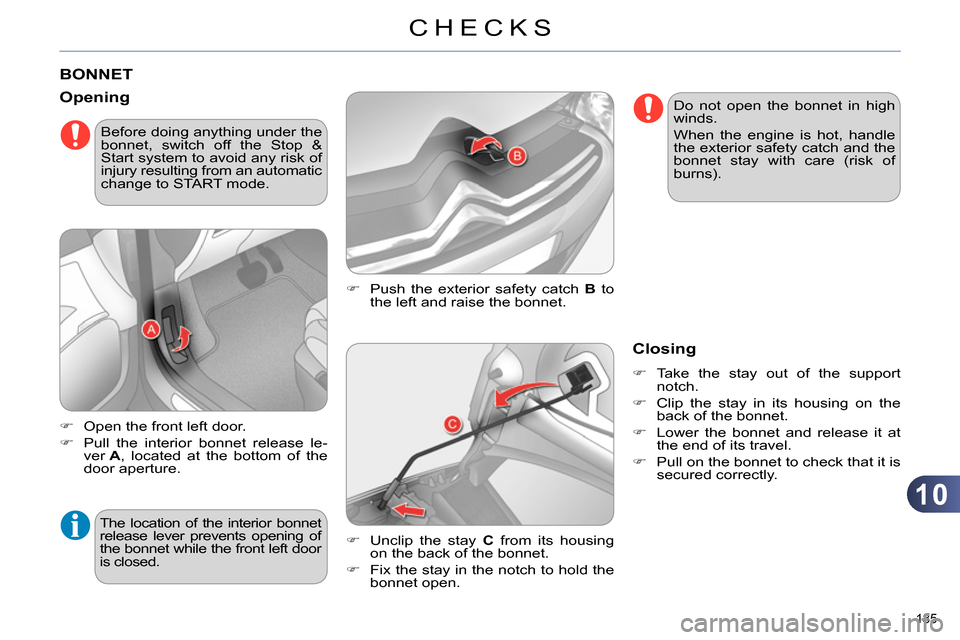
10
CHECKS
185
BONNET
Push the exterior safety catch B
to
the left and raise the bonnet.
Opening
Open the front left door.
Pull the interior bonnet release le-
ver A
, located at the bottom of the
door aperture.
Unclip the stay C
from its housing
on the back of the bonnet.
Fix the stay in the notch to hold the
bonnet open.
The location of the interior bonnet
release lever prevents opening of
the bonnet while the front left door
is closed.
Closing
Take the stay out of the support
notch.
Clip the stay in its housing on the
back of the bonnet.
Lower the bonnet and release it at
the end of its travel.
Pull on the bonnet to check that it is
secured correctly.
Do not open the bonnet in high
winds.
When the engine is hot, handle
the exterior safety catch and the
bonnet stay with care (risk of
burns).
Before doing anything under the
bonnet, switch off the Stop &
Start system to avoid any risk of
injury resulting from an automatic
change to START mode.
Page 193 of 340

10
CHECKS
191
CHECKS
Particle emission filter (Diesel)
The start of saturation of the particle
emissions fi lter is indicated by:
- fi xed illumination of the par-
ticle emissions fi lter warning
lamp, accompanied by an
audible signal and a message
that there is a risk of blockage
of the particle emissions fi lter.
The presence of this label, in particular
with the Stop & Start system, indicates
the use of a specifi c 12 V lead-acid bat-
tery with special technology and specifi -
cation. The involvement of a CITROËN
dealer or a qualifi ed workshop is essen-
tial when replacing or disconnecting the
battery. On a new vehicle, the fi rst op-
erations of regeneration of the
particle emissions fi lter may be
accompanied by the smell of
"burning", which is perfectly nor-
mal.
Following prolonged operation
of the vehicle at very low speed
or at idle, you may, in excep-
tional circumstances, notice the
emission of water vapour at the
exhaust on acceleration. This
does not affect the behaviour of
the vehicle or the environment. As soon as the traffi c conditions per-
mit, regenerate the fi lter by driving at a
speed of at least 40 mph (60 km/h) until
the warning lamp goes off.
If the warning lamp stays on, refer to
the "Additive level" section.
Unless otherwise indicated, check
these components in accordance with
the maintenance and warranty guide
and according to your engine.
Otherwise, have them checked by a
CITROËN dealer or a qualifi ed work-
shop.
Air filter and passenger compartment filter
Refer to the maintenance and
warranty guide for details of
the replacement intervals for
these components.
Depending on the environ-
ment (e.g. dusty atmosphere)
and the use of the vehicle
(e.g. city driving), replace
them twice as often if necessary
.
A clogged passenger compartment fi l-
ter may have an adverse effect on the
performance of the air conditioning sys-
tem and generate undesirable odours.
Oil filter
Replace the oil fi lter each time
the engine oil is changed.
Refer to the maintenance and
warranty guide for details of
the replacement interval for
this component.
12 V battery
The battery does not require
any maintenance.
However, check that the ter-
minals are clean and correctly
tightened, particularly in sum-
mer and winter.
When carrying out work on the battery,
refer to the "12 V battery" section for
details of the precautions to be taken
before disconnecting the battery and
following its reconnection.
Page 215 of 340
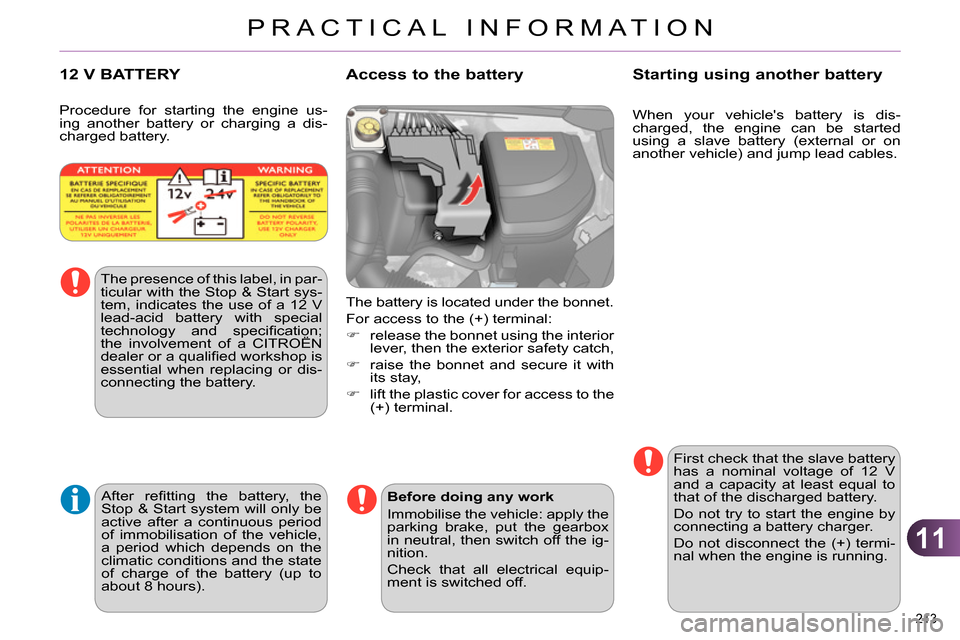
11
PRACTICAL INFORMATION
213
When your vehicle's battery is dis-
charged, the engine can be started
using a slave battery (external or on
another vehicle) and jump lead cables.
Starting using another battery
12 V BATTERY
The battery is located under the bonnet.
For access to the (+) terminal:
release the bonnet using the interior
lever, then the exterior safety catch,
raise the bonnet and secure it with
its stay,
lift the plastic cover for access to the
(+) terminal.
Access to the battery
The presence of this label, in par-
ticular with the Stop & Start sys-
tem, indicates the use of a 12 V
lead-acid battery with special
technology and specifi cation;
the involvement of a CITROËN
dealer or a qualifi ed workshop is
essential when replacing or dis-
connecting the battery.
Procedure for starting the engine us-
ing another battery or charging a dis-
charged battery.
After refi tting the battery, the
Stop & Start system will only be
active after a continuous period
of immobilisation of the vehicle,
a period which depends on the
climatic conditions and the state
of charge of the battery (up to
about 8 hours).
First check that the slave battery
has a nominal voltage of 12 V
and a capacity at least equal to
that of the discharged battery.
Do not try to start the engine by
connecting a battery charger.
Do not disconnect the (+) termi-
nal when the engine is running.
Before doing any work
Immobilise the vehicle: apply the
parking brake, put the gearbox
in neutral, then switch off the ig-
nition.
Check that all electrical equip-
ment is switched off.